Rappresentazioni e implicazioni sociologiche della deformità in Elephant Man di David Lynch
Titolo Rivista SALUTE E SOCIETÀ
Autori/Curatori Antonio Rafele, Guerino Bovalino
Anno di pubblicazione 2020 Fascicolo 2020/2
Lingua Italiano Numero pagine 12 P. 44-55 Dimensione file 148 KB
DOI 10.3280/SES2020-002004
Il DOI è il codice a barre della proprietà intellettuale: per saperne di più
clicca qui
Qui sotto puoi vedere in anteprima la prima pagina di questo articolo.
Se questo articolo ti interessa, lo puoi acquistare (e scaricare in formato pdf) seguendo le facili indicazioni per acquistare il download credit. Acquista Download Credits per scaricare questo Articolo in formato PDF

FrancoAngeli è membro della Publishers International Linking Association, Inc (PILA)associazione indipendente e non profit per facilitare (attraverso i servizi tecnologici implementati da CrossRef.org) l’accesso degli studiosi ai contenuti digitali nelle pubblicazioni professionali e scientifiche
In a convergence between sociology of media and visual studies, this paper proposes an inquiryon the representation of deformity in Elephant Man, and shows in conclusion the significantvariations that two current objects of the present imagery, the pornography and thevirtual reality, make on the subject. If in the cinema of the eighties, the deformity is still fullyassociated with the definition of a social norm, in a persistent and ambiguous dialecticbetween scene and off scene, in the most recent images of consumption, the deformed occupiesthe center of the scene becoming the principle of aesthetic experience. This polarity,studied in its narrative forms and its sociological implications, constitutes the reflexive centreof this article.
Parole chiave:Cinema; deformità; natura; media; immagine; mito.
Antonio Rafele, Guerino Bovalino, Rappresentazioni e implicazioni sociologiche della deformità in Elephant Man di David Lynch in "SALUTE E SOCIETÀ" 2/2020, pp 44-55, DOI: 10.3280/SES2020-002004